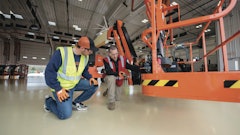
As the school year gets underway, high school juniors and seniors are weighing their next steps after graduation. Some may already have a clear direction, but many are staring down a future clouded by uncertainty. Universities are contending with budget cuts, student debt looms large and white-collar career paths are increasingly saturated and competitive. One pathway that has long been undervalued, however, is trade school, which offers stability, growth and a direct pipeline into industries eager for fresh talent. One particular industry in great need of fresh talent is construction.
The Growing Gap in Skilled Labor
The shortage of skilled tradespeople is not a future problem. It is a crisis happening right now. Today, the average age of laborers is in the early 40s, and in some skilled trades, this number is in the mid-50s. Retirements are accelerating, while fewer young people are entering the field, creating a widening gap that impacts projects across the country. ABC predicts that the industry will need to bring in nearly 500,000 new construction workers in 2026 to keep up with rising project demand.
This imbalance shows up across projects in tangible ways. Fewer workers mean stretched crews and slower schedules, which in turn drive up costs and put quality at risk when deadlines remain fixed but teams are under pressure. While project managers can plan for these challenges by building contingencies into timelines and budgets, the long-term solution lies in attracting, training and retaining the next generation of skilled tradespeople.
Why Trades Should Be a First Choice
Too often, skilled trades are seen as a fallback option for students who do not pursue a four-year degree. This perception is outdated and damaging, both for the individuals making career decisions and for the industries that depend on their work. In reality, trades offer compelling advantages. Many allow workers to earn while they learn, combining paid apprenticeships with hands-on training rather than burdening students with tens of thousands of dollars in tuition debt. Skilled craftwork also provides long-term job security, as these roles cannot be outsourced or automated and remain essential to communities.
For those who show dedication and initiative, clear pathways exist for growth, with opportunities to advance into supervisory, entrepreneurial or project leadership roles. Trades also offer the unique satisfaction of seeing one’s work endure – buildings, bridges, and infrastructure stand for generations, carrying the pride of the people who built them. Changing the perception of trades from a “last resort” to a “first choice” is one of the most important steps the industry can take in addressing the workforce gap.
How to Attract the Next Generation
Closing the labor gap will require creativity and commitment from across the industry. Owner’s representatives, contractors, educators and policymakers all have a role to play. The most effective strategies include:
Early Exposure: Getting students on jobsites early makes a major difference. When young people can work with their hands, experience the scale of a project, and see the impact of their contribution, career possibilities come into focus. Reintroducing woodshop, auto shop and other hands-on classes into high schools would also help an entire generation discover skills and passions beyond traditional classroom learning.
Earn-and-Learn Pathways: Apprenticeships tied to real projects remain one of the most powerful tools for workforce development. Students earn a paycheck while developing expertise, creating both financial stability and confidence. Apprenticeships also build loyalty: when young workers are invested in a project, they are more likely to stay with a firm or transition into a long-term facilities role after completion.
Mentorship and Knowledge Transfer: Pairing apprentices with seasoned professionals ensures that technical skills are taught alongside values, work ethic and pride in craftsmanship. Mentorship bridges generational divides and helps pass down intangible lessons that no classroom can replicate.
Modernizing the Work: Younger generations are drawn to environments that leverage technology and forward-thinking methods to make work efficient. This includes tools like digital modeling, robotics, and data-driven project management, along with modular construction and prefabrication, which streamline processes and enhance collaboration.
Long-Term Opportunities: Finally, connecting apprenticeships to permanent roles is key. Firms that link project training to ongoing facilities or maintenance work ensure not only continuity for the client but also career stability for young workers. This strategy turns short-term labor solutions into lasting workforce pipelines.
A Success Story in Action
One clear example of these strategies at work comes from a recent hospitality project our team worked on. From the very start of construction, TriCelta Development partnered with a local high school to recruit apprentices. These students were paired with mechanical, electrical and plumbing subcontractors, with the long-term goal of transitioning into the property’s facilities team after completion.
Over the multi-year project, the apprentices not only gained technical expertise but also developed deep pride in their contributions. When the property opened, several were hired full-time as subject-matter experts for the systems they had helped build and operate.
Building the Workforce That Builds the Future
For the construction industry, the truth is simple: success depends on the craft workforce. Without skilled tradespeople, even the best plans and designs remain just drawings on paper. Investing in the next generation of trades is not only about filling a labor shortage — it is about protecting quality, controlling costs and ensuring that projects can serve communities for decades to come.
Each of us in the industry has a critical role to play. By supporting workforce development, embedding apprenticeship and local hiring commitments into project plans, and fostering partnerships between schools and subcontractors, construction leaders can ensure that every project builds not only structures but also careers. The call to action is clear: the trades must be reframed as essential, rewarding, and forward-looking careers. The future of construction, and the strength of the communities it serves, depends on it.




















